Menu
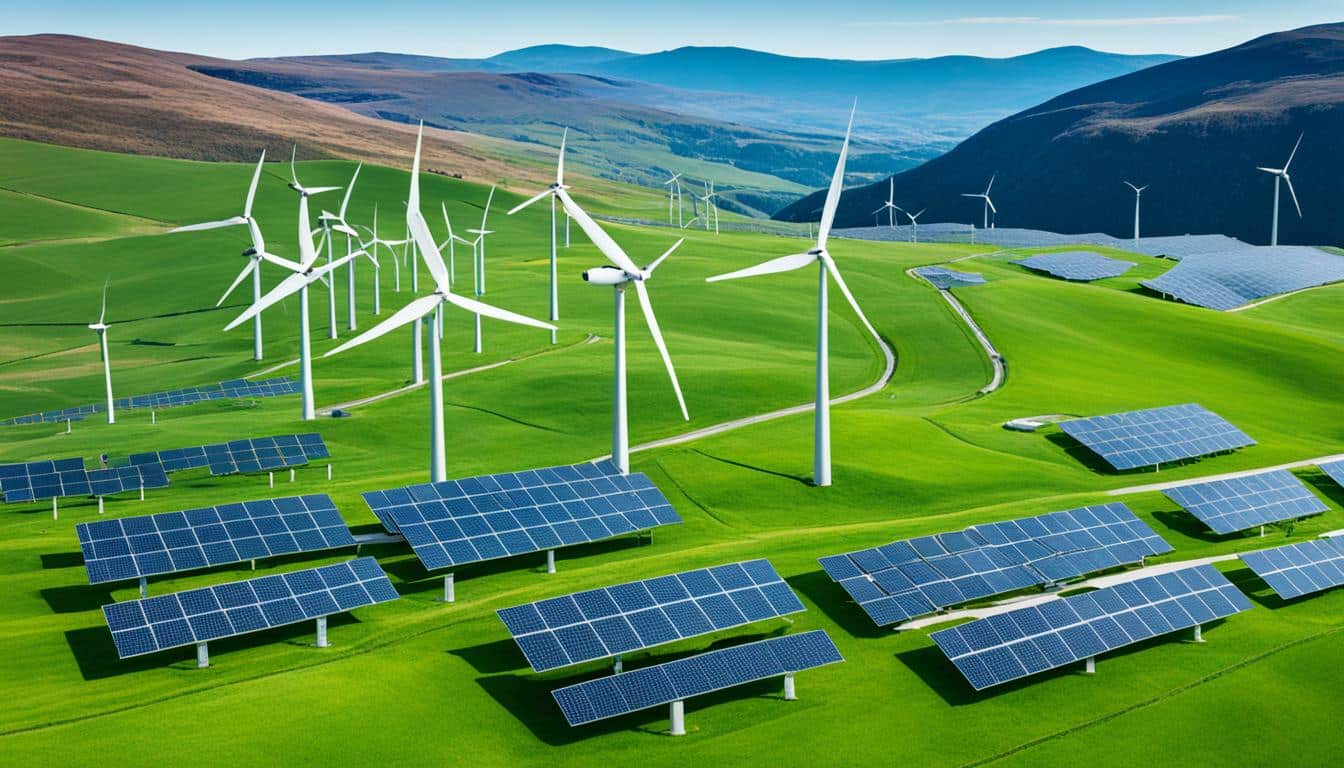
Fossil fuels are the main source of global greenhouse gas emissions, making up more than 75%. They also contribute to nearly 90% of carbon dioxide emissions. This information highlights the pressing need to switch to renewable energy. Over the years, renewable energy has played a crucial role in fighting climate change. It accounts for about 29% of the world’s electricity production.
Notably, the costs for solar and wind power have dropped significantly. Solar energy prices have fallen by 85% from 2010 to 2020. Meanwhile, wind energy has also become cheaper. This shift to renewable energy is vital for our environment. But it’s also a key driver for economic growth, promoting sustainable development and ensuring energy security.
Using renewable energy is key in tackling carbon reduction and preventing global warming. These clean energy sources cut down on harmful greenhouse gas emissions. These emissions cause the Earth’s average temperature to rise, leading to extreme weather changes.
Much of the world’s greenhouse gas emissions come from burning fossil fuels. Yet, renewables already power nearly a third of Earth’s electricity. This change is vital for fighting global warming. Between 2010 and 2020, the price of electricity from wind and solar power significantly decreased. Solar energy costs reduced by 85 percent. Such reductions make these clean methods of generating electricity more affordable and environmentally friendly.
Turning to clean energy is not only smart but also crucial. The International Renewable Energy Agency states that by 2050, 90 percent of electricity must be from renewable sources. The Paris Agreement underlines these goals, aiming for big carbon cuts. Countries are increasingly looking to renewable sources. Take the UK for example. It’s at the forefront, producing a quarter of its electricity from wind. This is the highest among the world’s major economies. It shows a worldwide push towards renewables, marking a significant step in global warming mitigation.
Investing in renewables helps the environment and creates jobs. Though the fossil fuel industry received $7 trillion in subsidies in 2022, renewables need $4.5 trillion every year. This investment aims at reducing emissions to zero by 2050. It’s not just good for the planet. It’s also a chance to create many new jobs in the clean energy sector.
The shift to renewable energy also supports economic growth sustainably. By 2030, renewable energy could cover 65% of the world’s electricity demand. It aims to make 90% of the energy sector free from carbon by 2050.
In short, advancing renewable energy is critical for fighting global warming. It’s the cornerstone of an eco-friendly future, slashing emissions and offering global economic and environmental advantages.
Making our homes energy-efficient is important. It’s not just for saving money. It helps the planet by reducing our energy use. We can make changes that save a lot of energy in our homes.
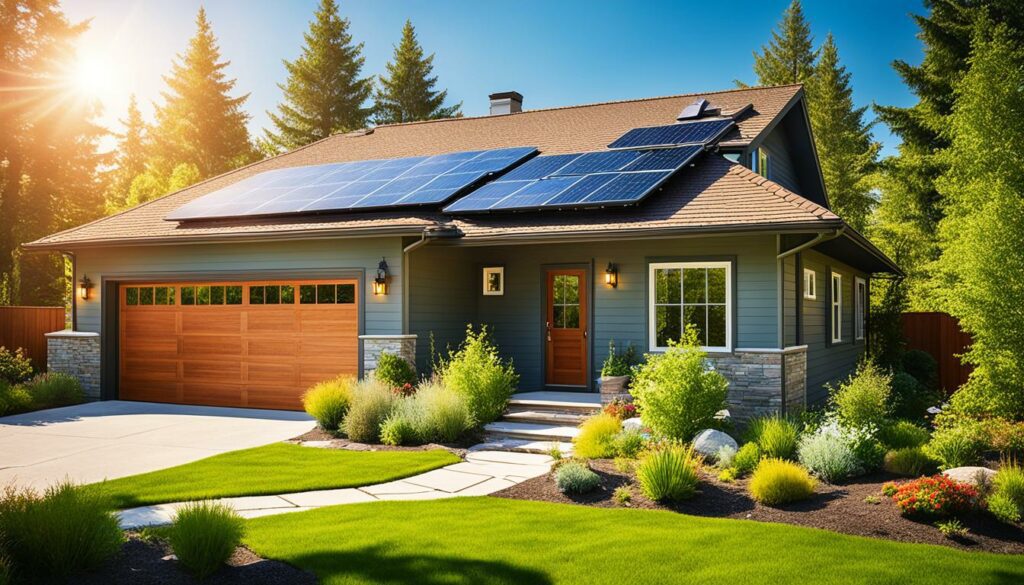
One easy way to use less energy is by setting your water heater to 120°F. This step doesn’t change your daily habits much. Yet, it cuts energy use a lot. It helps lower your bill and saves energy.
Changing your thermostat settings can make a big difference. In winter, set it a bit cooler. In summer, set it a bit warmer. This eases the strain on your heating and cooling systems, saving energy. It keeps your home comfortable while using less energy.
Choosing ENERGY STAR® appliances is key for energy efficiency. These appliances use less energy than normal ones. They help save money and protect the environment. Investing in them is good for your wallet and the planet.
Smart home technologies and energy-efficient lighting are changing the game in how we live greener at home. These new gadgets help cut down on our home’s carbon footprint a lot.
Smart homes use devices that we can control from afar. They work together for better energy use, making life cosier while being kinder to the planet. For instance, smart thermostats and lights help keep an eye on electricity use, which means less waste and better performance.
Moving from old light bulbs to LED and CFL lights is an easy, but effective, green step. These lights use much less energy and last longer. This leads to lower energy bills and fewer times you need to buy new lights. They also stay cooler, helping keep your home comfortable and saving even more energy. Their use supports the worldwide effort to cut down on greenhouse gases and live more sustainably.
| Lighting Type | Energy Consumption | Lifespan | Environmental Impact |
|---|---|---|---|
| Incandescent | 60 W | 1,200 hours | High |
| LED | 10 W | 25,000 hours | Low |
| CFL | 14 W | 8,000 hours | Moderate |
Choosing these new technologies brings many benefits. It saves money, helps the planet, and is a key part of today’s green living efforts. Governments also back these changes, pushing for more eco and wallet-friendly solutions.
Switching to renewable energy requires moving away from traditional fossil fuels. We should use more solar and wind energy. Fossil fuels cause a lot of greenhouse gas emissions. This change is crucial for the planet’s health.
Right now, about a third of the world’s electricity comes from renewables. But, by 2050, 90 percent could come from these sustainable sources. This big move is not just good for the Earth. It also brings economic benefits and makes our energy supply more secure.
| Metric | 2010 | 2020 |
|---|---|---|
| Reduction in Cost of Solar Energy | – | 85% |
| Reduction in Cost of Onshore Wind Energy | – | 56% |
| Reduction in Cost of Offshore Wind Energy | – | 48% |
Putting money in renewable energy doesn’t just cut carbon emissions. It also creates lots of jobs. For every dollar spent on renewables, three times more jobs are made compared to fossil fuels.
By 2030, renewables could create around 14 million new jobs. This would mean 9 million extra jobs worldwide. So, the job market wins big with renewable energy.
We can also save loads of money. By 2030, cheap renewable electricity could cover 65 percent of the world’s electricity needs. Also, cutting down on pollution might save us $4.2 trillion each year by 2030.
But still, huge amounts of money go to fossil fuel subsidies. We need to invest around $4.5 trillion a year in renewables up to 2030. This is to enjoy the benefits of a cleaner, cheaper energy.
“The updated Scoping Plan aims to achieve carbon neutrality by 2045, including reducing greenhouse gas emissions by 85% and cutting air pollution by 71% by 2045.”
Choosing green energy plans can help support the shift to renewables. Green energy means less carbon in the air. It also means a future where we live in harmony with our planet.
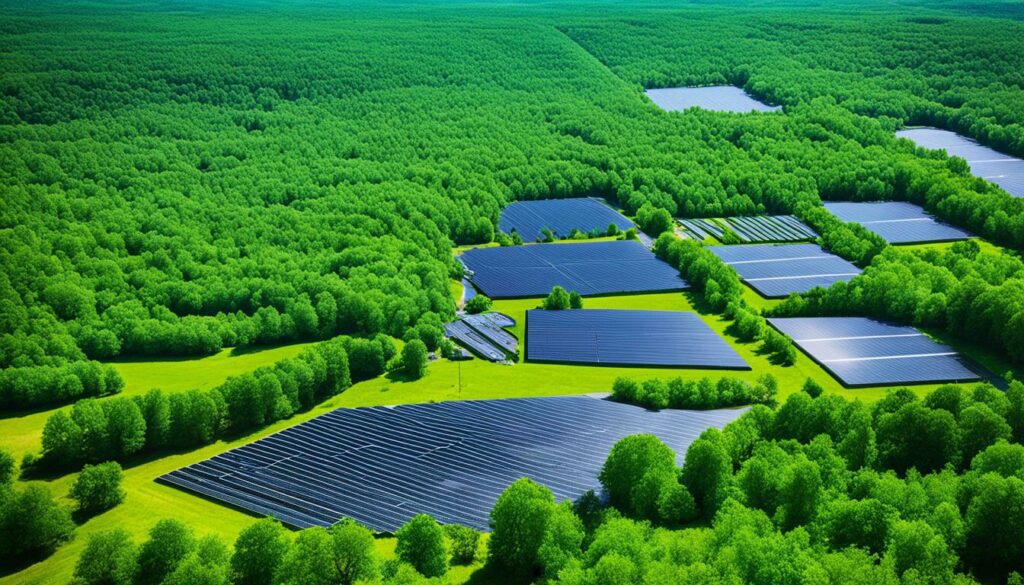
Using renewable energy is key to a better future. It can replace traditional fuels like oil. These are the main causes of global warming.
Solar power systems are becoming more popular. This is because solar panels are cheaper now. The cost of solar electricity dropped 85% from 2010 to 2020. This makes it a great choice for homes and businesses. Today, 29% of electricity worldwide is from renewables. Experts think this could hit 90% by 2050.
Wind power is a big option for making energy. The U.S. wind industry had over 100,000 jobs in 2016. Also, $13.0 billion was spent on wind projects that year. The cost of wind power has gone down a lot in the last decade. This shows its growing importance in global energy use.
Hydropower sustainability uses moving water for power. It’s cleaner than oil, making less pollution. By 2030, 65% of power could be from clean sources like this. Choosing hydropower can also help cut down on using oil, which harms the planet.
| Aspect | Solar Energy | Wind Energy | Hydropower | t
|---|---|---|---|
| Cost Reduction (since 2010) | 85% | Onshore: 56%, Offshore: 48% | Not specified | t
| Carbon Emissions (CO2E/kWh) | 0.07 – 0.2 | 0.02 – 0.04 | 0.1 – 0.5 | t
| Job Creation Potential | 260,000 in 2016 (U.S.) | 100,000+ in 2016 (U.S.) | 66,000 in 2017 (U.S.) | t
| Energy’s Share of Market by 2050 | 90% combined share for all renewable sources (IRENA) | t||
Industries contribute a lot to CO2 emissions in the United States, almost 30% of the total. To lower this, they must work on industrial energy savings and update their modern manufacturing processes. This could help industries cut their carbon output.
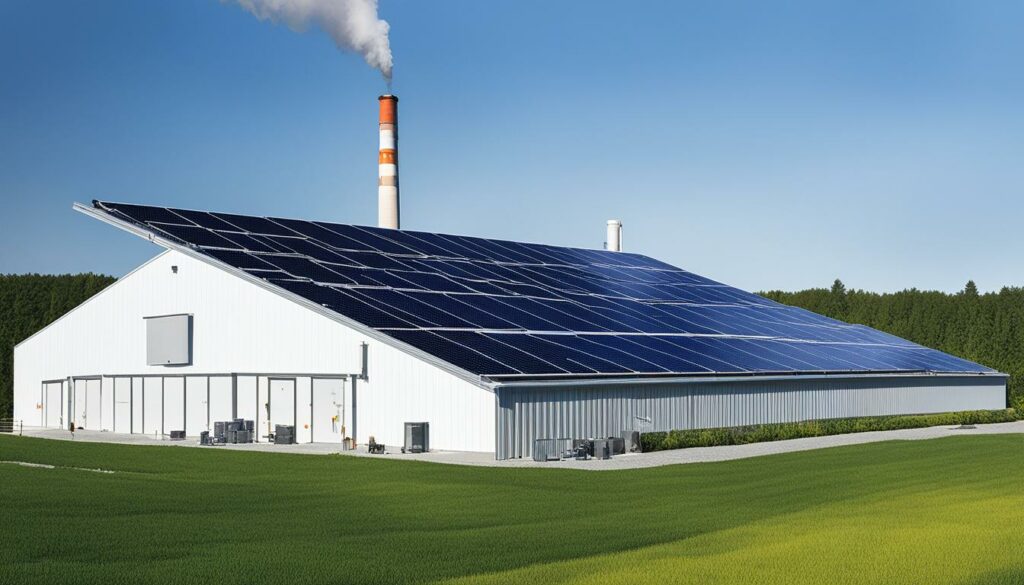
Performing energy audits in factories is a smart move. These audits find out where energy is wasted and how it can be saved. The U.S. Department of Energy’s Industrial Assessment Centres assist factories in finding and applying these energy-saving steps, especially those in need. This approach improves how factories use energy, cutting down on CO2.
Updating factory processes with automation is also key. Automation makes work smoother and uses energy better. For example, in making petroleum, a lot of emissions come from cracking oil. Using advanced automated systems can make this process cleaner.
Industries like chemical manufacturing and iron and steel (which use a lot of coal and energy) can benefit hugely from these steps. Using the latest tech in these areas will help reduce their big carbon footprints.
| Industry | CO2 Emissions (Million Metric Tonnes) | Energy Efficiency Improvement Potential |
|---|---|---|
| Petroleum Refining | 700 | Significant with Automation |
| Chemicals | 400 | High through Process Optimisation |
| Iron & Steel | 300 | Substantial via Modern Techniques |
| Food & Beverage | 200 | Prominent with Energy Audits |
| Cement | 100 | Moderate through Innovative Methods |
In conclusion, working on energy efficiency is critical for industries to be greener. By refining industrial energy savings and promoting modern manufacturing processes, they can do their part in reducing carbon emissions. This approach helps them meet the worldwide goal of net-zero emissions by 2050.
The transportation sector creates a big part of the U.S.’s carbon emissions, at 29%. To cut down on this, we need to shift to more eco-friendly ways of moving.
Electric cars play a big part in lowering emissions. They are becoming more popular because their technology is getting better and cheaper. The U.S. has a plan to make transportation completely green by 2050. Also, there’s now a lot of money going into sustainable transport, like better electric car charging and city planning.
Electric cars bring many advantages, such as saving money on petrol and needing less upkeep. They also bring down harmful emissions and help keep energy supplies safe. Making these electric cars creates more jobs and helps save fuel. This is all part of a big move towards greener ways of getting around.
Making public transport better is key to lowering the mobility sector’s carbon footprint. On average, public transport is much greener than using a private car. For example, subway trains produce a lot fewer emissions for each person they carry than cars.
When buses are full, they cut emissions by a big amount. For a 10-mile daily trip, swapping from a car to a bus can significantly reduce your carbon footprint. The Energy and Transportation Office helps the Department of Energy and the Department of Transportation work together on green transport.
| Mode of Transportation | Emissions Reduction (%) |
|---|---|
| Heavy Rail Transit | 76% |
| Full Occupancy Bus Transit | 82% |
| Public Transport (general) | 33%-82% |
If we invest in electric cars and make public transport better, we’ll see a big drop in harmful emissions. This is crucial for a greener and healthier future.
Community support is key to community-led projects working well, especially in the energy sector. Nearly 30% of clean-energy projects that didn’t involve the community enough have failed. Community opposition often comes from real concerns, especially in low-income areas. These places have seen health threats from industrial sites.
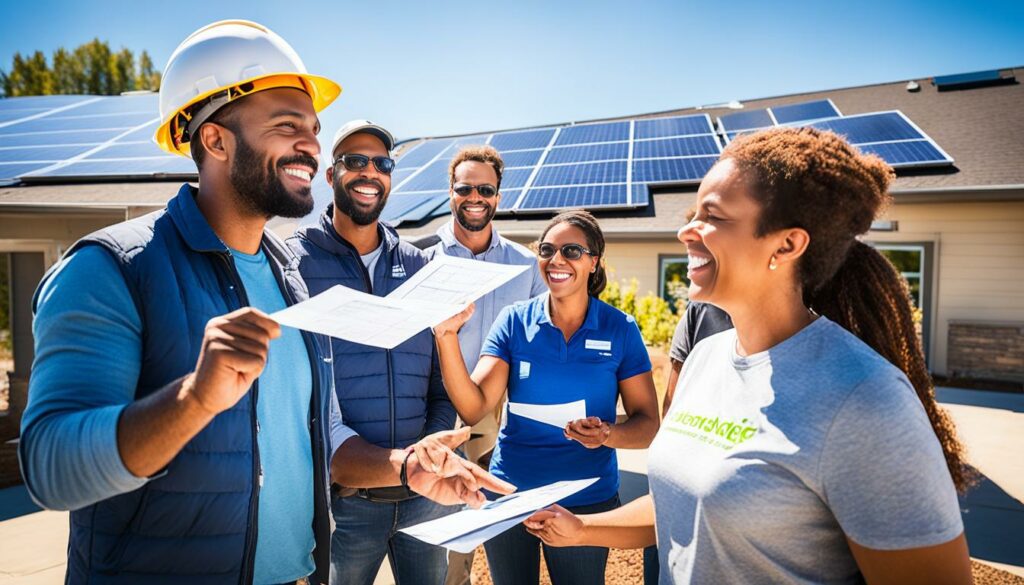
In Huntsville, a forum highlighted the need for new ideas in removing carbon dioxide and using clean technology. Jigar Shah from the U.S. Department of Energy talked about how essential it is to teach communities about these projects. The Biden Administration stresses the need for community participation to get federal funds, underlining how important grassroots involvement is.
Donnel Baird, CEO of BlocPower, suggested that involving local people in owning parts of energy projects could help a lot. Doing so supports renewable energy and makes sure the community’s needs are met from the start. Now, groups fighting for environmental justice have more power to stop projects that don’t consider the community.
Below, a table shows why community involvement is vital in energy projects:
| Key Aspect | Importance |
|---|---|
| Lack of Community Engagement | Major contributor to nearly 30% of project failures |
| Health Concerns in Low-income Areas | Significant local opposition grounded in real-world impacts |
| Changing Political Climate | Community engagement critical for federal funding |
| Educational Campaigns | Vital for securing community buy-in |
| Ownership Stakes | Facilitates large-scale deployment of clean energy |
Supporting grassroots involvement and renewable energy advocacy is crucial for success. It helps meet both short and long-term goals for the environment. Teaching the community and giving them a role is fundamental in reaching our targets.
Creating a carbon-conscious lifestyle means making small but important changes in how we live. For instance, adjusting our water heaters to 120˚F saves energy. This won’t affect our daily life much. We can do similar things with our home’s temperature, making it warmer in summer and cooler in winter.
To stop energy being wasted, we should unplug appliances we’re not using. Changing old light bulbs to LED or CFL types also helps. It saves energy and reduces waste because these bulbs last longer.
There are more ways to be eco-friendly that boost our energy efficiency. We can use less water by installing low-flow showerheads and toilets. Buying ENERGY STAR® appliances helps, too. They use less energy than older ones. By checking our home’s energy use, we can spot where to make the most important changes.
Recycling well and buying wisely are key to looking after our planet. Things like using reusable bags and choosing products that last a long time make a big difference. We can also help by giving away clothes we don’t wear anymore. Choosing to shop at stores that care about the environment shows we stand for what’s right.
| Activity | Impact on Carbon Footprint |
|---|---|
| Turning down water heaters to 120˚F | Energy savings with no daily impact |
| Adjusting thermostats seasonally | Substantial energy usage reduction |
| Unplugging appliances | Prevents standby power consumption |
| Switching to LED/CFL bulbs | Extends bulb life, reduces waste, saves energy |
| Using low-flow showerheads/toilets | Significant water usage reduction |
| Updating to ENERGY STAR® appliances | Enhances home energy efficiency |
On the path to a carbon-conscious lifestyle, picking eco choices is important. We should recycle, give away old clothes, and support green businesses. By doing this, we show we’re serious about cutting our carbon footprint and looking after our world.
Governmental support is key for clean energy to take off. Policies and incentives make a big difference. They help deal with financial and technical challenges.
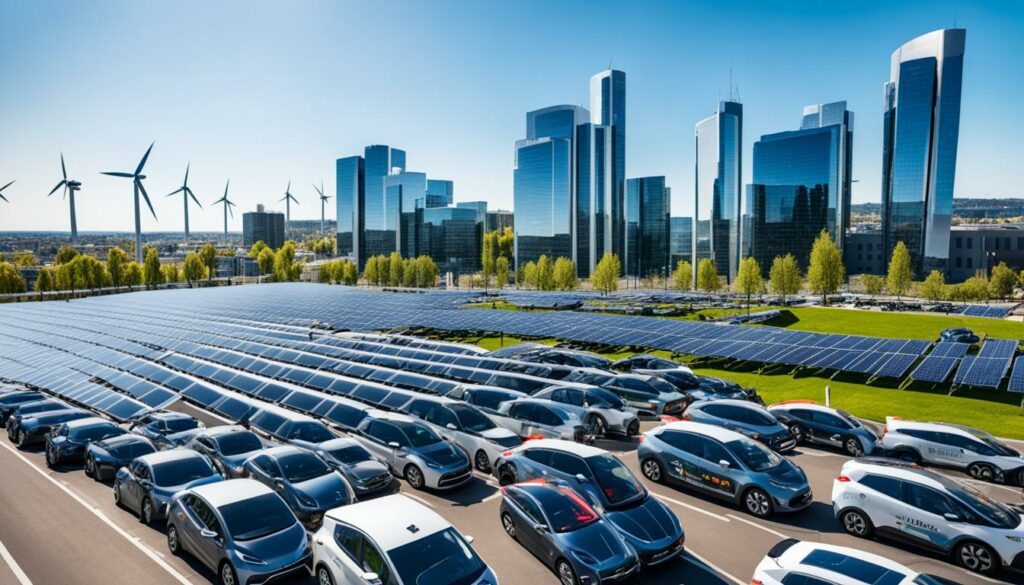
Tax breaks are a big help for investing in green projects. Studies show that financial incentives boost green energy. Combining feed-in tariffs with tax benefits and soft loans is very effective. This mix drives the growth of clean energy.
Green investment subsidies and grants are also crucial. OECD countries use various tools to push for renewables. These include direct aid and regulations on fossil fuels. Such support lowers costs, helping both companies and people choose sustainable options.
Challenges exist, like not enough infrastructure and technical problems. Overcoming these needs more than just money. It also takes educating the public to fight misconceptions. The COVID-19 crisis has shown the value of renewable energy. It shifted our energy use, underlining the role of clean energy.
This highlights the ongoing need for strong government support. It’s essential for the growth of renewable energy.
Investing in carbon offset projects is a smart way to lessen hard-to-remove emissions. It lets people and groups take part in reducing their carbon footprint. Buying carbon offset certificates helps to balance your environmental impact.
Carbon offsets let you compensate for greenhouse gas emissions. This is done by funding projects that cut or capture these gases. For example, projects range from saving forests to setting up renewable energy sources.
One such project is Xcel Energy’s effort to manage 186,000 acres of forest and plant 8,600 trees in Minneapolis. This has a big impact on reducing carbon in the air and helping the climate stay stable.
Buying carbon offset certificates is straightforward. You can get them from several places, like Xcel Energy. They’ve put $300,000 into local projects, leading to 15,000 carbon offsets.
These certificates not only offset your emissions but also support important environmental causes. For instance, efforts to protect 45,000 acres of grassland in Colorado or recycle harmful refrigerants.
It’s important to check the credibility and effect of projects you fund. Also, focus on reducing your own emissions first. Choose projects wisely, like those that help with cooling cities and creating homes for wildlife. These kinds of projects make your investment have even more positive effects.
| Project | Impact | Location |
|---|---|---|
| Forest management | 186,000 acres conserved | Colorado, USA |
| Tree planting | 8,600 trees planted | Minneapolis, USA |
| Grassland preservation | 45,000 acres protected | Colorado, USA |
| HFC refrigerant recycling | 2,500 pounds recycled | Various |
Corporate sustainability is now a must, not a choice. Companies need solid plans to lower their carbon footprint. In the U.S., 27% of greenhouse gas emissions came from transport in 2020. This shows there’s a rush to reduce these emissions.
Many firms are going green by buying carbon offsets. This can lessen their total carbon emissions. By using more solar and wind power, businesses make a real difference. Plus, it’s good for their image with eco-aware customers.
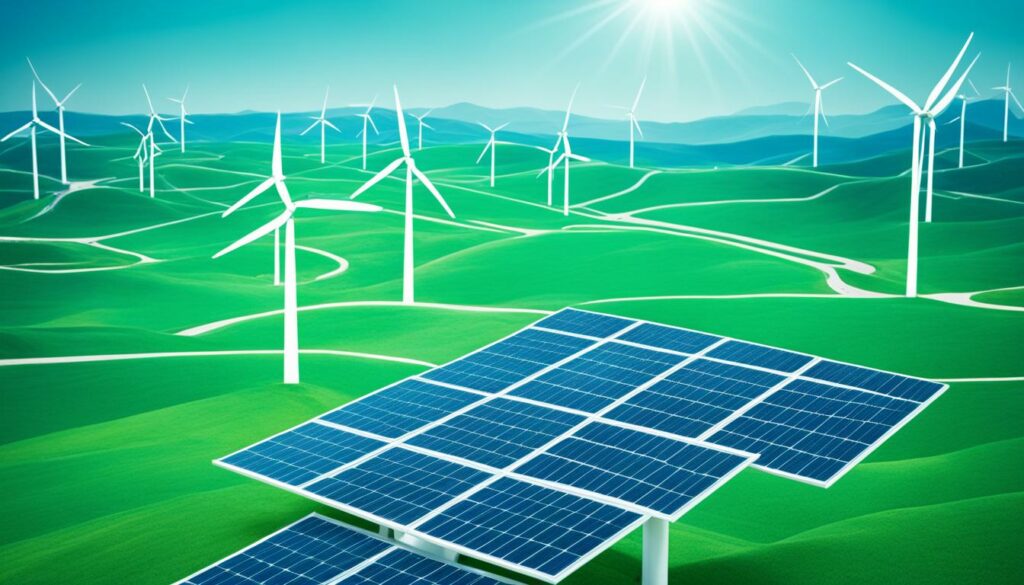
Cutting waste in the office is a big step in reducing carbon footprints. Actions like online filing, recycling, green packaging, and ditching one-use plastics help. They can tackle the 292.4 million tons of waste the U.S. creates each year.
Choosing eco-friendly suppliers is also key. They help firms do better in sustainability. Using ESG software allows for better tracking and meeting emission goals. This leads to smarter, more sustainable business plans.
Rules around business travel are also important. Things like promoting virtual meetings and cutting non-essential trips can help. Air travel makes a big carbon impact, and these steps lessen that.
Every bit helps when it comes to lowering emissions. These steps show a company cares about the planet and leads in saving it. They contribute to the worldwide fight against climate change too.
The future of renewable energy looks bright. It’s driven by big steps in technology and new ways to create clean energy. Energy storage is improving fast.
For example, more batteries are being installed each year. By Q3 2023, there were more installations than in the whole of the year before. This shows how quickly we’re getting better at storing energy.
Solar and wind power are also on the rise. In the U.S., solar energy hit a new high in 2023 with 31 GW installed. That’s a 55% gain from the year before. At the same time, wind energy saw an 8 GW increase, reaching a total of 147 GW. This growth means more people are using clean, renewable energy sources.
Over three-quarters of new energy in the U.S. comes from renewables with storage. This mix is boosting reliability and efficiency. And, the costs of setting up renewable energy sources are falling.
In terms of transport, things are changing too. A huge 1.2 million electric cars were sold in the U.S. in 2023. They made up 7.6% of all sales. With a predicted 2030 boom, more electric cars will hit the streets. This move towards electric vehicles is key for a greener future.
Government support for cleaner energy is on the rise. In 2023, the U.S. saw a jump in support for transmission projects. Also, 113 clean energy factories or expansions were announced. This investment totals over $421 billion. It shows a strong push for a more eco-friendly energy sector.
Looking ahead, renewable sources could make up almost half of global electricity by 2030. This would be a big jump from the current 30%. Such a change would be vital for the planet and the economy. It points to the critical role of clean energy growth and innovation in our future.
The road to being carbon neutral is tough. It needs a lot of work and team effort. Some of the main hurdles are about using new tech and money troubles. Both are big challenges to fixing. But by using new tech and better rules, we can face these issues. Now, let’s look into what makes reaching carbon neutrality so hard.
Getting more renewable energy can be hard because of the tech it needs. We must make our power networks stronger and better at storing energy. Companies are finding it tough to switch to ways that produce zero extra CO2.
Many small to medium-sized businesses aren’t sure how much CO2 they make. This is because they lack the skills and tools to keep track or cut down on it.
It’s tricky when money and policy stand in the way of being green. For example, starting to be more eco-friendly can be expensive. Also, some countries’ rules might not help enough. This affects about 40% of smaller businesses.
Some industries, like Japan’s plastics sector, make a lot of CO2 by burning waste. This shows we need better rules and more tech in these rough areas.
It’s also hard because going green costs a lot and keeps needing more money. There’s always this need for updating our green tech. But we can see hope in companies like Virgin Atlantic. They set big goals for cutting CO2 and work with new tech companies. This strategy can help jump these money hurdles.
To get the full picture of carbon neutral challenges, you can see them all in this table:
| Key Challenge | Details | Statistics |
|---|---|---|
| Technical Implementation | Scaling up renewables, improving grid infrastructure | Only 1 in 10 SMEs measure carbon emissions |
| Economic Barriers | High initial costs, continuous investment needs | 40% of SMEs face financial barriers |
| Policy and Regulation | Need for supportive policy frameworks | 36% of companies struggle with supply chain alignment |
The work towards more renewable energy and less carbon is vital in fighting climate change. New technology, clear policies, and involving the community help a lot. For example, Ali and colleagues (2021) show how important money and global connections are in making places like Ghana and Africa more green.
Also, Gyimah and others (2023) found that putting money in renewable energy brings good for both the environment and the economy. This means that green tech is key for how we grow our business, as said by Abokyi (2019) and Solarin (2020).
There are hurdles, but everyone working together – individuals, companies, and governments – can make a big change. Studies by Khan (2022) and Awan (2020) stress how crucial it is for us all to choose sustainable ways. So, by sticking to these efforts, we can make the world cleaner and better for those who come after us.
Renewable energy is key in moving away from fossil fuels. It cuts down on greenhouse gases, helping to slow global warming. This matches big goals, like the Paris Agreement.
Important agreements, like the Paris Agreement, show a global effort towards more renewables. Groups like the International Renewable Energy Agency (IRENA) set targets too. They want to use renewables more to fight climate change.
Simple steps can greatly improve how much energy your home uses. Try setting your water heater lower, at 120°F. Also, change your thermostat to use less energy. Using ENERGY STAR® products can help a lot.
Smart home gadgets work with your home to use energy better. Things like smart thermostats, lights, and fridges help save energy.
LED and CFL lights use less power and last longer than old bulbs. They also make less heat. This helps save energy and money.
Using solar and wind power instead of fossil fuels drops carbon emissions. This is a big step towards living sustainably.
Solar power is clean and available to many. It lessens our need for fossil fuels and lowers energy costs. This is good for homes and businesses.
Wind turbines create a lot of energy without using up fossil fuels. This helps the earth by cutting back on greenhouse gases.
Hydropower makes energy from moving water. It’s a big part of clean energy, replacing dirty fuels and keeping the planet healthy.
Energy audits find where energy is wasted at work. They suggest changes that cut down on use and help the planet.
Upgrading industry with new tech cuts down on wasted energy. This lowers the need for energy and decreases harmful emissions.
Electric cars are a big help in making transport cleaner. They use electricity instead of polluting petrol. This is better for the planet.
Trains and buses take lots of people places without adding much pollution. Using them helps keep the air clean in cities.
Community projects get everyone involved in clean, green living. They make people aware and work together to protect the environment.
Buying only what you need and using reusable things helps cut waste and pollution. It’s a small but important step towards a cleaner planet.
Government support like tax breaks for clean energy makes it easier to choose the earth over polluting ways. This support pushes for more green living.
Carbon offsets let us make up for polluting by supporting projects that lower more pollution. This includes green energy or saving forests.
You can buy carbon offsets online. Companies sell certificates that prove your support. Or you can directly fund clean projects.
Big companies are making plans to pollute less. They are setting targets based on science and inspiring others to join in caring for the environment. Stellantis is one example.
Looking ahead, we see better ways to store energy and smarter energy systems coming. These changes will make clean power more common and reliable.
Moving to all clean energy faces big tasks. We need better ways to make, store, and use energy. It also needs strong support from everyone and governments.